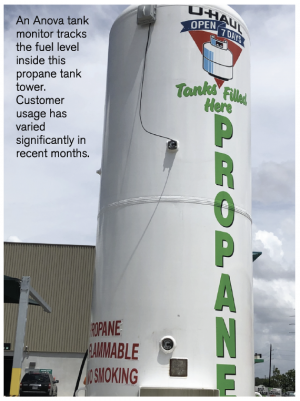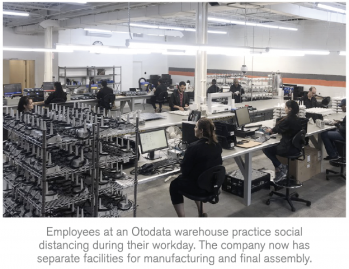All
Remote Monitoring Amid Social Distancing

Tank Monitors Aid Dealers & Customers Amid COVID-19 Crisis
Under normal circumstances, experienced heating fuel dealers can predict their customers’ delivery needs with at least some degree of accuracy. After March and April 2020, one wonders if the phrase “under normal circumstances” should be struck from the English language altogether.
As discussed at length in the May 2020 issue of Oil & Energy, heating fuel associations, wholesalers, retailers, and the companies that support them have responded admirably to the COVID-19 crisis. They’ve stepped up to assist their fellow essential businesses and local first responders while simultaneously making unprecedented changes to their daily operations in order to protect the health and safety of employees and customers.
It’s easy to see and understand how COVID-19 demands changes to in-home service protocol; after all, following recommended guidelines like maintaining six feet of distance, wearing a mask, and regularly washing one’s hands are the “new normal” for most everyone. What’s more difficult to process, let alone predict, is how this new business environment affects customers’ energy usage – especially when it comes to liquid heating fuels.
As the COVID-19 crisis swept across the Northeast and then the nation, sheltering guidelines have varied from one jurisdiction to the next, but eventually all states in the region had some form of stay-at home order in effect. Millions of commuters began working from home, and countless others became furloughed or unemployed — all found themselves “stuck inside” their residences longer, more often than usual, and just as the heating degree day season should have been winding down.
Did the increase in homebound customers and this past winter’s overall decrease in heating degree days balance each other out? It’s hard to say. One certainty is this: K-factors, degree day schedules and conventional automatic delivery programs were not created to work amid a pandemic. On the other hand, tank monitors and remote monitoring programs have never been more vital to heating fuel businesses and consumers.
For a better understanding of how this technology has helped fuel sellers adapt to today’s new and unpredictable circumstances, Oil & Energy spoke with several of the industry’s leading tank monitoring providers.

Increasing B2C Transparency
“With remote tank monitoring, distributors and dealers were able to see which customers had low tank levels, and who was not consuming at all,” says Chet Reshamwala, CEO of Anova Solutions, makers of Wesroc and ISA tank monitors for the fuel oil and propane industries. “Without tank monitoring, companies ultimately end up wasting time and resources by visiting tanks too often, or not reaching the tank before a runout.”
Preventing runouts, optimizing drop sizes and promoting overall operations efficiency have long been the stated goals of tank monitoring providers. However, in the current crisis, where uncertainty reigns supreme and accounts can vanish at the drop of a dime, fuel dealers and their customers are looking for reliability wherever they can find it. Tank monitoring apps and software, which can provide much-needed transparency for businesses and consumers alike, are just what the doctor ordered.
“We have absolutely seen increased interest from fuel dealers in areas with lockdown orders in effect,” Reshamala says. “These customers are realizing that information is power and being able to access your information from anywhere at any time is key.”
“During this pandemic, tank monitors helped fuel distributors and dealers maintain a high-quality of service by operating more efficiently, even with limited resources,” says AndrÈ Boulay, president of Otodata. The Canada-based tank monitoring company, which was recently featured on an episode of Advancements with Ted Danson on CNBC, provides its consumer-facing, custom-branded Nee-Vo app for free to all of its clients, enabling these fuel sellers to offer their customers the same benefits the companies enjoy from Otodata tank monitors – and then some.
“As most residential consumers were working from home, we saw increased usage of our B2C app, NEE-VO, which provides real-time tank levels,” Boulay says. Otodata’s clients’ customers can also use the NEE-VO app to request a delivery, get custom alerts, review their usage history and contact their dealer directly.
Reshamwala identified similar behavior among Anova clients and their customers. “There has absolutely been an uptick of end-user customer tank monitoring app usage since the beginning of lockdown,” he says. “Our customers’ customers are keeping a closer eye on their tanks and resources with the MyTankApp mobile app. At Anova, we have been very busy enabling our customers with this differentiating capability. They can send out marketing campaigns and take fill and other requests direct from their customer phones, but importantly, the app enables the end user to see their own tank level.”
Whether fuel dealers and distributors choose to deploy tank monitors and software solely for their companies’ own operational efficiencies or to directly market these devices with customer-facing apps, the benefits are clearer than ever in these uncertain times. “The level of business transparency enabled by remote tank monitoring will no doubt have long lasting impact for both those that have prioritized the commitment and investment in transforming their business through digitalization and those that have not,” Reshamwala says.
Especially now, the Anova CEO sees this digital dynamic in do-or-die terms. “The companies that survive this pandemic will emerge stronger, and everyone else will have to compete with them,” he says. “What distinguishes these survivors is their ability to harness data, derive insight, and act on it.”
“No matter the season, our analytics aid in our main objective, which is simply helping fuel distributors increase their delivery efficiency,” Boulay says. “Getting accurate tank level information is critical for fuel providers. It can substantially reduce their operating expenses while significantly improving their service level.”
LPGame Changer
As dealers readily recognize, tank level information is especially important for propane customers who utilize the fuel not just for heating and hot water but also outdoor kitchens, grills, pool heaters and countless other home appliances that see continued use throughout the year. Perhaps no company is better suited to assess the pandemic’s impact on propane equipment usage than Bergquist, Inc. The Ohio-based wholesaler offers home service companies virtually every kind of high-quality propane equipment under the sun, including — yes — tank monitors.
“We definitely saw an increase in orders, especially at the beginning of the pandemic,” says Bergquist Tank Monitor Sales Specialist Scott Gaudet. “Many propane marketers were not doing inside service work, so it was a perfect time to get monitors installed without having to come in contact with customers.”
Ironically for a customer-service and -safety driven industry, one of the ways propane businesses can safely serve their customers during a pandemic is by never seeing or coming into direct contact with them at all. Tank monitoring makes that easier. “It has helped propane marketers by eliminating unnecessary deliveries, which in turn has limited exposure through customer interactions,” says Gaudet.
“Being able to divert assets on the fly and quickly schedule or re-route deliveries to avoid runouts at essential services, puts these providers amongst the real heroes of COVID-19,” adds Reshamwala. “For the LPG industry, this means being able to best support those essential customers in agriculture, home heating, and warehouses that use dispensers and forklifts, as well as anyone relying on a backup generator that uses propane and diesel."
Streamlining Essential Services
“When the pandemic first began, there was one moment that made us particularly proud to be part of the fuel distribution industry,” remembers Anova CEO Chet Reshamwala. “A county in South Carolina was hit by a tornado and was struggling while no gas stations were operational in the area. One of our amazing customers noticed that their client, a marina, began using an odd amount of fuel. It was then discovered that this client was giving away fuel, five gallons at a time, to people who were struggling in the surrounding area to keep their generators running. Knowing this, Anova, our customer, and other local businesses were able to come together to make donations and donate fuel out of storage tanks in the area.”
Indeed, the versatility tank monitors allow has truly come in handy for the fuel dealers who serve first responders and other essential service providers.
“Many of our clients and their customers provided essential services throughout this pandemic,” Reshamwala recalls. “We heard of amazing, heroic stories where their ability to derive insight and take action to meet their customers’ needs simply set them apart.”
The ability to operate on-the-fly is especially important as new COVID-19 cases and so-called “hot spots” spring up in different parts of distributors’ service areas. “Due to the need for improvised or temporary COVID-19 testing and health care facilities, which require fuel to function, there was a definite increase in demand in that industry,” says Boulay. “Therefore, fuel distributors need to make sure to offer them a high level of service, so that these facilities don’t experience runouts as they generally run at 110-percent capacity.”
Not surprisingly, Bergquist saw increasing interest in tank monitors among its clients’ municipal and commercial customers. “Propane marketers wanted to ensure there were no interruptions of service for critical or essential businesses,” Gaudet says.
Tank monitoring providers agree that localization is key when it comes to serving essential businesses. “What really bears out here is that sense of coming together in a crisis,” Reshamwala says. “While our global footprint is large and diverse, at Anova, we have always valued localizing support and service. I think we’ll also see a broad and renewed industry focus on providing increased customer engagement and satisfaction at the regional level.”

Internal Adaptations
Of course, it’s just not just tank monitoring companies’ clients that have had to make significant changes in light of COVID-19. Tank monitoring companies themselves are in the same boat. And like many heating fuel dealers and distributors, they have found that at least some aspects of the new business environment might be worth keeping around for good.
“Otodata has responded on several different levels,” Boulay explains. “We have applied some changes to our production and supply chain departments by having multiple manufacturing and final assembly facilities, and our B2B support and marketing teams have been working remotely to ensure that our customers continue to receive their tank monitors and services in a timely manner during these trying times. The pandemic has put an enormous amount of stress on every aspect of our business, and we have had to adapt by finding ways to work with limited resources. We were forced to look at our processes closely and tighten our belts, focusing on the essentials. This exercise will undoubtedly be beneficial in our day-to-day business and it has prepared us for almost any eventuality.”
One change that some tank monitoring companies are considering making permanent is keeping remote monitoring salespeople working remotely. “We have moved our inside sales and accounting teams to work from home,” shares Gaudet. “We also put a number of protocols in place for our warehouse crews to limit their exposure to the virus. It took an investment to get our teams up and running remotely, but it has paid off. Our customers tell us we haven’t missed a beat in customer service. Looking ahead, we will probably have more people working from home, at least part of the time.”
“As an essential business ourselves, operations in our production units have continued to run throughout the pandemic,” Reshamwala says. “New guidelines on social distancing, PPE, employee health and safety, and wellness checks have kept our team safe. Most of our non-essential employees have been working from home since mid-March. Throughout, we are staying connected with frequent video chat meetings and roundtable discussions, and the occasional virtual celebrations.”
Like all of us, Reshamwala is unsure how long the pandemic will last but certain there are lessons to be learned from it and proud of how his team has adapted. “The pandemic has really shone a light on what we are all capable of even when we are out of our comfort zones,” he adds. “Our productivity as a company has not decreased just because we are all apart. It is hard to tell for sure what the future will hold for the rest of 2020 and beyond, but we are taking our employees’ thoughts and concerns into consideration as we take each step.”
The Bottom Line
Arnold Stillman, CEO of POEM Technology, sees in the crisis further proof of the advantages of cellular tank monitors over WiFi models. “Normally when installing a WiFi device, you have to ask the customer for their network, which requires some sort of interaction,” Stillman says. “With a cellular tank monitor, no interaction is necessary. Our installer accesses the customer’s outdoor tank, and with the push of a button it’s ready. Cellular networking was always a benefit, but the ability to more easily incorporate social distancing into your installation jobs is a new side benefit.” Stillman doesn’t see the trend toward cellular ending anytime soon. “Those available bands are becoming more and more common,” he says, “and the data plans are priced competitively enough with equivalent WiFi plans that the end user sees no difference.”
Should a resurgence occur this fall, as most experts predict, heating fuel dealers and distributors who haven’t yet deployed tank monitoring might reconsider the potential benefits for their businesses or be left trailing in the dust. If this past heating season is any indicator of the technology’s potential, tank monitors can:
- mitigate the impacts of quarantined customers’ unpredictable and varying fuel usage;
- identify unused residential and commercial accounts for possible closure; and
- provide a service add-on or up-sale that does not require an in-home visit;
- all while delivering much-needed transparency, reliability and efficiency that will continue to benefit the provider long after the pandemic ends.
The bottom line: if not now, then when?
Related Posts
 Why Quality Matters in Your Biofuel Blends
Why Quality Matters in Your Biofuel Blends
Posted on June 25, 2025
 HEAT Show Gears Up
HEAT Show Gears Up
Posted on June 25, 2025
 What’s Next in Boiler Technology
What’s Next in Boiler Technology
Posted on June 25, 2025
 How Intelligent Are Your Integrated Customer Platforms?
How Intelligent Are Your Integrated Customer Platforms?
Posted on June 25, 2025
Enter your email to receive important news and article updates.
